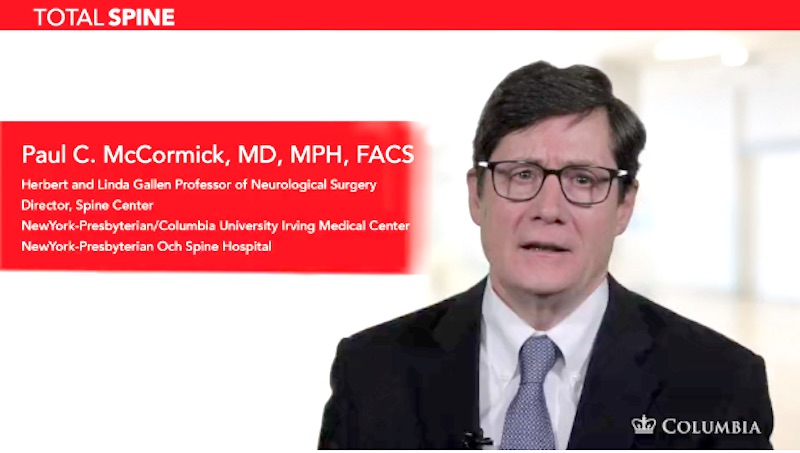On an otherwise normal workday in 2015, Taylor Joseph was sitting at his desk. Suddenly, he says, he lost all feeling and movement in his face. “Whoa,” he thought. “Did I just have a stroke?”
It wasn’t a stroke, but a herniated disc in his neck.
Just a few years before, Taylor had been an outstanding college athlete—captain of Columbia’s football team. But Taylor’s time on the gridiron caused some problems in the joints of his neck. After graduation, his neck started bothering him. Then it got worse.
“Over the course of four or five years, I saw probably five or six specialists,” he says. But the pain increased. “I went from lifting weights at 300 and 400 pounds, to just hurting a lot when I woke up out of bed.” But the pain was odd. “It wasn’t just aches and pains,” says Taylor. “It was more like numbing.”
The pain, and his inability to find relief from it, affected his personality. “I really started getting angry, not liking work or anything. I went from being a very outgoing, jovial person to basically being cradled indoors… I stopped doing anything except working,” he says.
And then came the day at work that his face went briefly numb. In that moment, he says, “I realized I needed to take this very seriously.”
Taylor had never wanted to think about surgery, but now he was spooked. He didn’t know where to find out about surgical options, but he had a pretty good idea who would know: his freshman year dorm-mate, Alex Sisti.
Alex is “the smartest person I know,” says Taylor, “and his dad is [Columbia neurosurgeon] Dr. Michael Sisti.” So, says Taylor, he texted his friend. “ ‘Yo Alex, I need to know who I should see,’ and Alex said, ‘Let me ask my dad.’ ”
Alex’s dad got back to the young men quickly. Dr. Sisti recommended Spine Hospital Director Dr. Paul McCormick. In fact, says Taylor, he heard that Dr. Sisti called Dr. McCormick “the most gifted surgeon of any surgeon he knows.” “Wow,” says Taylor. “The smartest man I know says the smartest man HE knows says this guy is the best.” That was a pretty solid recommendation, so Taylor made an appointment.
When he came to that appointment, Taylor felt right away that he had made the right choice. He recalls Dr. McCormick as being “so prestigious, but not in an arrogant way. He just had this big leather chair, a big massive MacBook screen, and he was all business.” And it turned out that he and Dr. McCormick had something in common: Dr. McCormick had also been captain of the Columbia football team in his day.
They got along immediately and Dr. McCormick’s manner made Taylor feel comfortable. “He just got his recorder going and said, ‘Sit down and tell me about your problems.’”
After Dr. McCormick had heard from Taylor, conducted a neurological exam (a test of reflexes, strength, range of motion, sensation, etc.) and examined the MRI scans, he explained what seemed to be going on.
One of the discs, or jelly-like cushions between bones, had moved out of the correct position in Taylor’s neck. The gel-like center of the disc burst through the tougher outer layer, causing pain and numbness when it interfered with nearby nerves, and even with the spinal cord itself.
Taylor explains: “Basically, the disc went from a jelly pad into lots of little fragments. One of the fragments was lodged fairly close to a nerve, so when I did certain movements, it would hit that nerve and I’d get paralyzed for a second. Like, if I looked over my right shoulder or if my jaw moved a certain way, I would literally fall to the ground.”
The situation wasn’t great, but Taylor wasn’t entirely ready to sign on for surgery either. Would he just need more and more surgery in the future? No, explained Dr. McCormick. In Taylor’s case, Dr. McCormick could replace the herniated disc with an artificial disc that would last the rest of his life. Given Taylor’s young age and good health, there was every reason to expect the surgery would be very straightforward.
Over the next few days, Taylor thought about the appointment—especially what Dr. McCormick said in the last few minutes. “Basically,” says Taylor, “he said, ‘I’m always trying to prevent surgery by giving patients options when there are things they can do to prevent surgery. I’ll only tell someone they have to have surgery if it’s a very grave situation.’ And, he said, ‘I’m just shy of telling you that you have to have surgery.’ ”
Taylor talked it over with his family, who were on the other side of the country. They were concerned for Taylor, but they weren’t fans of surgery.
Taylor pored over the Columbia site, watching surgical videos and reading patient stories. One stood out to him. “There was a video of a lady who had a tumor removed from her spine as a baby. Then it came back when she was pregnant, so she had the fear of losing her first child. It was ultimately a success story—Dr. McCormick saved her. He removed the tumor after an 18-hour surgery or something bananas like that. So maybe this kind of surgery, my kind, is just a quick ding, dang—no big deal for him. But to me, it’s a big deal.”
And Taylor thought about the years of pain. “It’s hard to express to someone else what it was like, how intense it was. Because no one else is in your body. But when the pain is like that, the pain is your body.”
After this deep consideration, discussion and research, the decision was easy. “That appointment was on Thursday, and I booked the surgery on Monday,” says Taylor. With a smile, he adds, “That’s after it took me six years to go see him.”
When the day of surgery came, Taylor says, “I was anxious, scared, grumpy, excited, all at the same time. But everyone was so comforting.” Taylor remembers going into intake and talking to a very nice resident and then a helpful anesthesiologist. Then, he woke up and Dr. McCormick was at his feet. The surgery was over. It had gone perfectly.
Taylor was surprised by the speed of the recovery in the hospital. He was on his feet again later that day. The very next day, he was ready to be discharged. His mom had flown in from California to be with him, and she happened to be away from the hospital. But he was so anxious to get home, “I didn’t even wait for my mom. I just took an Uber back to my apartment.”
To complete his recovery, he rested there for a total of four weeks. But he wasn’t out of touch with his surgeon. “Dr. McCormick unconditionally answered his messages, and he picked up his cell phone on the weekends to call me when I was recovering.”
Today, Taylor says, he’s better than ever. He has a full range of motion. No pain. A scar so small people can’t see it even when he points it out. He moved back to California to be with his family and found a new job he loves. “I don’t even have the right words. For the first time, I feel amazing. I have my life back.”
And he is extraordinarily grateful to Dr. McCormick for that. “He’s the man. He’s my angel. He’s everything a surgeon should aspire to be. He’s the top of the top, and there’s no joke about that. He’s undeniably a life-changing figure to me, and I’m forever indebted to him.”
Learn more about Dr. McCormick on his bio page here.




